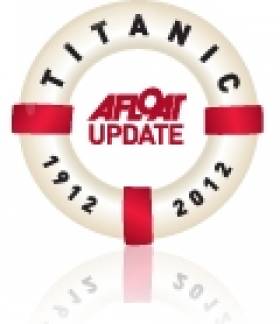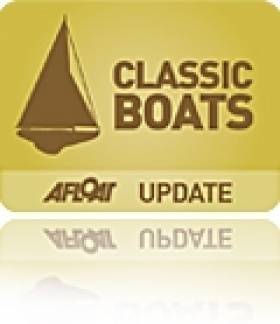Displaying items by tag: Cill Airne
A former Mersey ferry, the Royal Daffodil is to be transformed as plans reveal that the historic river-ferry is set to become an "iconic visitor attraction" with a food, drink and events space.
The Royal Daffodil which was originally named the Overchurch when completed in 1958 by Cammell Laird Shipbuilders, had began service for Birkenhead Corporation Ferries in 1962.
The 860 passenger ferry was in regular service on the Mersey bringing commuters between Liverpool and the Wirral Peninsula and is also where the shipbuilder is based.
In addition to routine commuter crossings, Royal Daffodil carried out Liverpool Bay cruises also from city's famous waterfront (Pier Head) and inland along the Manchester Ship Canal to the city's Salford Docks.
The ferry which was renamed Royal Daffodil in 1999, would continue in service for more than a decade serving Mersey Ferries until the 54 year old vessel was decommissioned in 2012. See, Mersey Ferries newbuild story.
Currently, the veteran vessel is being refurbished having fallen into a dilapidated state.
According to InsiderMedia, Liverpool City Ships is now looking to give the 46m long former ferry, which has four decks, a permanent home at the city's Canning Dock. This is situated close to the ferry's former Pier Head terminal.
The 468 gross tonnage vessel is to be given a revamp with the plan to make the ship into a heritage asset and be a mixed-use venue.
As part of the revamp, the promenade deck is to house a drinking establishment with outdoor drinking area space. More on the story here which mentions that the main deck is to be transformed into a restaurant.
Afloat adds a similar project involving a new restaurant was carried out for the Dublin static-based MV Cill Airne river-venue that also features two bars, one based with art-deco features.
Both vessels have a resemblance, as the Overchurch (Royal Daffodil) and the 1962 Liffey Dockyard built Cill Airne were designed by the same naval architects, Graham and Woolnough of Liverpool.
Cill Airne was built as a trans-Atlantic liner tender in Cobh before changing a role as a navigation/radar training ship in Cork Harbour.
The 501 gross tonnage vessel however was made obsolete in 2003 as a computer bridge simulator formed part of the then new National Maritime College of Ireland.
Restoration of Titanic’s Tender SS Nomadic Completed
#TitanicTender – S.S. Nomadic as previously reported on Afloat.ie, is a veteran of two world wars and has a direct link to the luxurious RMS Titanic past, and Charlie Chaplin and Elizabeth Taylor who have been on board the passenger liner tender.
As of today, the last remaining vessel of the White Star Line, will be open for visitors in her dry-dock next to the Titanic Belfast Visitor Centre and close to where she was launched in 1911 at Harland & Wolff.
She was built to ferry first and second class passengers to RMS Titanic from Cherbourg in France, a port too small for what was at that time the largest ship in the world. For more on this the BBC reports.
Afloat.ie adds that another former trans-Atlantic liner tender that served in Cork Harbour, (Titanic's last port of call), the T.S.M.V. Cill Airne ran from Cobh out to the liners during a short career until the early 1970's.
The Dublin-built vessel launched in the early 1960's is now a static restaurant and bar venue and is also open to visitors today and throughout the Dublin Port River Festival (1-3 June).
#ClassicShip – It won't be all about vessels under sail as the veteran T.S.M.V. Cill Airne, which served as a trans-Atlantic passenger liner tender in Cobh, will be open to the public as part of the inaugural Dublin Port River Festival (1-3 June), writes Jehan Ashmore.
Throughout the three-day festival, the Cill Airne will have an Open Day between 11am to 6pm.
Since 2006, the Cill Airne has been moored as a static restaurant and bar venue along Dublin's North Wall Quay.
As previously reported on Afloat.ie, last year she celebrated a major milestone, having been built 50 years ago at the nearby old Liffey Dockyard.
To celebrate her half-century, the Irish branch of the World Ship Society (WSS) based in Cobh held a special luncheon on board in the beautiful timber surroundings of the Quay 16 Restaurant.
The 500 tonnes vessel is also unique in that she is the last ship built from the yard.
Research has indicated that she along with her sister Blarna were built with rivetted hulls, this was a political one, designed to ensure employment of the last riveting crews at the dockyard.
This made Cill Airne unique to Dublin's maritime industrial heritage but also significant in that this outdated shipbuilding technique was still in practise in a European shipyard.
Why not come on board during the festival and explore this rare example of a surviving Irish built vessel.
In addition the upper decks will provide an opportunity to gain a higher elevation of the myriad of boating traffic and with Tallships berthed either side along the quays.
On Saturday the Howth 17's, the world's oldest one-design keelboat class still racing will indeed be doing just that!...and on Sunday the Old Gaffers 'Parade of Sail'.































































